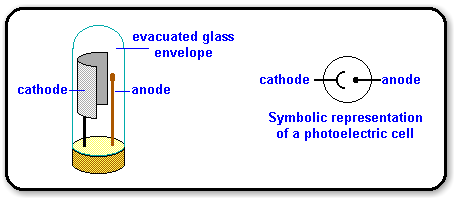 |
 |
 |
 |
 |
 |
 |
 |
 |
 |
 |

|
Applications of the Photoelectric Effect |
|
| A thorough understanding of the photoelectric effect has helped spawn useful applications in many areas of physics, or even create new areas of study. The most obvious example is probably solar energy, which is produced by photovoltaic cells. These are made of semi-conducting material which produce electricity when exposed to sunlight. An everyday example is a solar powered calculator and a more exotic application would be solar power satellites that orbit around the earth. Engineers are developing new applications for solar energy. | |

|
More details on photovoltaics.
Click here for an audio story about the use of solar energy out in space from Science@NASA or here for the text version. |

|
|
|
The photo-cell is the most ranging of applictions of the photoelectric effect. It is most commonly found in solar panels. it works on the basic principle of light striking the cathode which causes the emmision of electrons, which in turn produces a current. |
|
|
In the related field of astronomy, the photo-electric effect is used in the form of photo-multiplier tubes and charge coupled devices (CCDs).
Learn more about Coupled Devices.
The electron photo-multiplier tube makes use of the photo-electric effect to convert small intensities of light into electrcial currents which can be analyzed. Electrons dislodged by the photo-electric effect travel down a special tube gathering more electrons. By the time they get to the end, a single electron can have gathered a million other electrons. CCDs are special plates that are analogeous to photographic film, but instead store electrons in a two dimensional array. They are not only used for astronomy however, as they can be found in digital video and still cameras. More info of the photoelectric effect in astronomy. The photoelectric effect is used in a plethora of other devices, including photocopiers, light meters and even electronicsl components such as photodiodes and phototransistors. |
|
|
The other fabulous application fo the photoelectric effect is scintillators. A scintillator is a device that will emit light when it detects radiation from either a source in the lab or a cosmic source (cosmic radiation is known as muons). | |
